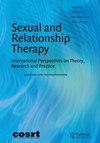Clinical reviews editorial: discovering connections
IF 1.4
4区 心理学
Q3 PSYCHOLOGY, CLINICAL
引用次数: 0
Abstract
We have all been there – reading through multiple content tables, scanning abstracts... looking for a semi-quick answer to the question, “Is this article going to give me a good suggestion for helping with my clients’ concerns?” As sexologists, it is always a bit of a battle to bridge the gap between research and practice. This is true for many disciplines, but in the field of sex we often find ourselves mixing the two and yet not distinctly identifying how a research outcome can be applied in “real life,” nor how a clinical application can be applied to (or from) the next big break through. While a brief editorial is not able to cover or explain all of the applications – a summary of sorts may be beneficial, especially if it attempts to bridge a connection. In this issue of Sexual and Relationship Therapy, there is a wide range of articles spanning topics such as menopause, desire and functioning, teaching sex therapy, transgender relationships, sex workers, and assessments. There are qualitative, quantitative, and even mixed methods studies represented – all providing incredible insight. As I reviewed the articles in this issue, I saw a very general overlap related to permission-based work in sexual and relationship therapy, which will be the theme of this first Clinical Reviews Editorial. Permission-based therapy and interventions is nothing new, but the way in which it is being adapted to today’s clientele is under development (Belous et al., 2019a). Historically, permission was utilized in sex therapy to free clients from the burden of social oppression by providing the “okay” to engage in sexual experiences that they were interested in – we know this as the first stage/step of the PLISSIT [permission, limited information, specific suggestions, and intensive therapy] model developed by Jack Anon in 1976. This original model was expanded in 2007 by Taylor and Davis to incorporate an extended version of permission throughout the model – giving permission (and getting it) at each step. This type of work, where a client’s autonomy and ability to retain their own power of choice, is incredibly important to ensuring positive outcomes and effective treatment. Permission work includes honoring the client’s ability to choose what to disclose, at what pace, and ensuring continued consent in the conversation and therapy process. It is actually a quite simple task and is directly related to enthusiastic consent in sexual activity practices (Coy et al., 2016). Throughout, and often, the therapist should gain the permission, check in with the client that the topic is still okay and that they are willing to continue, and that everything is going in a direction in which they are comfortable. If the client is not comfortable or unwilling to continue – their wishes should be honored, and a pause is placed on the therapy topic until the client is临床评论社论:发现联系
我们都有过这样的经历——通读多个内容表,浏览摘要……寻找一个半快速的答案来回答这个问题,“这篇文章会给我一个好的建议来帮助我的客户解决问题吗?”作为性学家,弥合研究和实践之间的差距总是有点像一场战斗。许多学科都是如此,但在性领域,我们经常发现自己将两者混为一谈,却没有明确地确定研究成果如何应用于“现实生活”,也没有明确地确定临床应用如何应用于(或来自)下一个重大突破。虽然一篇简短的社论无法涵盖或解释所有的应用程序,但各种各样的摘要可能是有益的,特别是当它试图建立联系时。在这一期的《性与关系治疗》中,有很多文章涵盖了更年期、欲望和功能、性治疗教学、跨性别关系、性工作者和评估等主题。有定性的,定量的,甚至混合的方法研究代表-所有提供令人难以置信的洞察力。当我回顾这期的文章时,我看到了与性和关系治疗中基于许可的工作相关的非常普遍的重叠,这将是第一期临床评论社论的主题。基于许可的治疗和干预并不是什么新鲜事,但它适应当今客户的方式正在发展中(Belous等人,2019a)。从历史上看,许可被用于性治疗,通过提供“可以”来参与他们感兴趣的性体验,从而将客户从社会压迫的负担中解放出来——我们知道这是PLISSIT(许可,有限信息,具体建议,强化治疗)模型的第一阶段/步骤,由Jack Anon于1976年开发。Taylor和Davis在2007年对这个原始模型进行了扩展,在整个模型中加入了许可的扩展版本——在每个步骤中给予许可(并获得许可)。这种类型的工作,客户的自主权和保留自己选择权力的能力,对于确保积极的结果和有效的治疗非常重要。许可工作包括尊重来访者选择透露什么、以什么速度透露的能力,并确保在谈话和治疗过程中得到持续的同意。这实际上是一项相当简单的任务,与性活动实践中的热情同意直接相关(Coy等人,2016)。在整个过程中,通常,治疗师应该获得客户的许可,与客户确认这个话题仍然是可以的,他们愿意继续,一切都朝着他们感到舒适的方向发展。如果来访者感到不舒服或不愿意继续——他们的愿望应该得到尊重,并且暂停治疗话题,直到来访者感到舒服
本文章由计算机程序翻译,如有差异,请以英文原文为准。
求助全文
约1分钟内获得全文
求助全文
来源期刊

Sexual and Relationship Therapy
PSYCHOLOGY, CLINICAL-
CiteScore
3.80
自引率
9.10%
发文量
37
期刊介绍:
Sexual and Relationship Therapy is a leading independent journal in its field, well established and internationally recognized. It offers an active, multidisciplinary forum for review and debate across the spectrum of sexual and relationship dysfunctions and therapies. The journal presents original research and best practice and is a vehicle for new theory, methodology, and application. Sexual and Relationship Therapy is edited by a respected international team and publishes contributions from around the world. It is the official journal of the British Association for Sexual and Relationship Therapy (BASRT).
 求助内容:
求助内容: 应助结果提醒方式:
应助结果提醒方式:


